On the previous page, we gave you a simple framework for ensuring you gat a good variety of angles and positions in your images. Her, I want to show you some examples, primarily from our students, of clever photos, well angled and positioned with explanation of how they would have been achieved.
Treat these as a little inspiration vault - hopefully now you will have a better idea of how to capture similar!
Flat angle - parallel to the ground
Photographers love shooting at a flat angle because whether you lift your camera up high or low, whether you zoom in a lot or keep a wide angle, you can always build in a lot of depth in the image and stack together elements that are blurry ( in the foreground and background) and sharp ( where you point your focus)
Top tip - you will be achieve that effect more if you either zoom in ( unless you are using a phone camera with only digital zoom - some cameras have both optical and digital zoom) or use a wider aperture ( that's if you already know what you are doing with your camera and lenses)





Follow a wall ( or ground or any flat surface)
This is still technically shooting at a flat angle, but I wanted to single it out because it's such an underrated technique among starting photographers. What we are essentially doing is finding a flat surface that your subject either is on, or next tom and placing your camera virtually ON that same surface, pointing at your subject. This forces your camera to grab a portion of that surface - be it a wall, a table, a bed or even the ground. The key thing here is that your camera will not be able to make that flat surface sharp close to the camera so you will get a lovely gradual blur which thins into sharpness once you get to your subject. A really easy way to incurporate colour, texture and depth into your image, without distracting from your subject.







High jumps - shooting upwards
If you want to capture your children leaping up in the air, you absolutely must get yourself ( or at least your camera) lower than the anticipated height of their jump. That is the only way to make the camera notice a gap between the ground and their feet so that when it captures it as a photograph, you can tell a chhild is actually up in the air. If you shoot from up above and pointing down, you will only ever see your children against a background of the ground, without any understanding of the height or even that they are jumping at all.


AIming high - shooting upwards
Shooting upwards is not just for high jinks - it can bring a unique perspective to your images, place you in a position of your child and show the world from an 'ants view'




Take a swing
There are quite a few things that can make or break your swing images, but one that people often get wrong is positioning. A bit like with capturing jumps, getting low and pointing your camera upwards will help you create the illusion of a more dramatic height.


Looking down







Are you ready to capture something unique yourself? Make sure to share your images on our Facebook group!